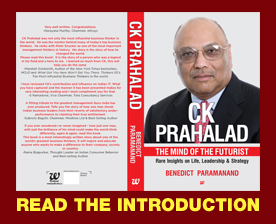It’s interesting that Cognizant and Infosys are two Indian ompanies that Rita Gunther McGrath researched for her book The End of Competitive Advantage: How to Keep Your Strategy Moving as Fast as Your Business. The Columbia Business School professor would have done her research at least two years ago for it to be published by Harvard Business Press in June 2013.
Two years is a long time these days in business. It turns out that what these two Indian companies are experiencing is the central theme of the book – that the concept of sustainable competitive advantage is dead and that the new era belongs to those who sift the market for opportunities at quick speed and grab them – what she calls transient advantage. Cognizant is growing at quick speed at double digits in difficult market, while Infosys, a front runner till recently, appears to be searching for what its transient advantage is. Fearing further regression, Infosys founder Mr. Narayana Murthy announced a come-back in June 2013. Expectations are high.
McGrath rues that most leaders are using frameworks that were designed for a different era of business and based on a single dominant idea–which the purpose of strategy is to achieve a sustainable competitive advantage. She also proves that the urge to hold on to one’s established competitive advantage is a vicious trap. Today’s dynamic markets require continuous reconfiguration. The author shows how strategies that worked well for you even a few years ago no longer deliver the results. Dramatic changes in business have unearthed a major gap between traditional approaches to strategy and the way the real world works now.
Apart from making her point strongly, the author offers paths that leaders can adopt to avoid getting trapped. Disruptive innovation guru, Clayton Christensen says this book is one of the most illuminating takes on how to deal with disruption that he has ever read.
Prevent asset build-up
McGrath argues that firms need to increasingly compete with waves of temporary or transient competitive advantage rather than sustainable competitive advantage. She stresses the fact that although exploitation of a transient advantage is advantageous for a period of time, excessive build-up of assets and people should be prevented as much as possible so that barriers to moving on to the next advantage are minimized.
It’s clear that today stability, not change the most dangerous in highly dynamic competitive environments. Organizations that have mastered transient-advantage environments are those who believe in continual freeing up of resources from old advantages in order to fund the development of new ones.
Mc Grath’s other books include Discovery-Driven Growth: A Breakthrough Process to Reduce Risk and Seize Opportunity (2009), Market Busters: 40 Strategic Moves That Drive Exceptional Business Growth (2005), and The Entrepreneurial Mindset: Strategies for Continuously Creating Opportunity in an Age of Uncertainty (2000). In 2009 McGrath was inducted as a Fellow of the Strategic Management Society, an honor accorded to those who have had a significant impact on the field.












Recent Comments